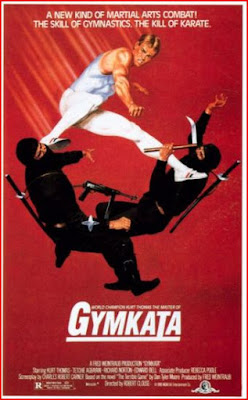In The Slave, the son of Spartacus and Varinia is named Randus and raised to be a Roman soldier. By 48 B.C. he's a centurion in Julius Caesar's army as it occupies Egypt. Caesar (Ivo Garrani) gives him a sensitive mission to spy on Marcus Licinius Crassus (Claudio Gora), Spartacus's nemesis and one of Caesar's few remaining rivals for dominion over the Roman world, in his power base in Zeugma. In the English dub, Crassus's voice actor seems to make an effort to imitate Lawrence Olivier at times. More intriguingly, Randus has a Germanic sidekick (Franco Balducci) who resembles Kirk Douglas a good deal more than Steve Reeves does, as if Corbucci wanted us to think for awhile that that guy might be the son of Spartacus.
Nevertheless, Randus learns of his true heritage, and the meaning of the Thracian trinket he's worn around his neck since childhood, after an accident at sea strands him and slave girl Saida (Ombretta Colli) in a strange country where they are promptly captured and enslaved. A fellow slave is a veteran of Spartacus's rebel army who recognizes the trinket as the sign of the son of Spartacus. Whether Randus believes this or not, he doesn't care to be enslaved and leads a successful rebellion just before his erstwhile shipmates arrive to rescue him and fetch him to Zeugma.
Randus is possessed of innate compassion. We saw it displayed early in the picture when he mercifully stabbed a rebel to death in mid-crucifixion. He despises cruelty and so comes to despise slavery. After visiting Spartacus's grave -- we're told his remaining followers stole the great man's body from the cross and took it to the City of the Sun -- he embraces fully the role of Son of Spartacus, appropriating the helmet, breastplate and sword that conveniently have been left atop the old man's sarcophagus, unmarred by time or desert climate. Randus becomes a masked avenger, part Moses, part Zorro down to signing his work with a big S, though the more immediate model was the recent Reeves vehicle Goliath and the Barbarians. By harassing Crassus he continues to do Caesar's work as well as his father's. Once that work is done, however, Randus and Caesar's interests inevitably diverge.
Steve Reeves performs tremendous feats of strength as the Son of Spartacus
Corbucci makes the most of his picturesque locations and clearly knows his way around the widescreen frame, but he's not as good at peplum action as he would be at spaghetti western gunplay. He's good at horseback chases through the desert, but like most peplum directors he never really figures out how to make swordplay as dynamic as contemporary Asian filmmakers could. The Slave is the same sort of episodic, essentially juvenile adventure that Hollywood made ad nauseum in the 1950s, only with superior art direction if not a higher budget.
Above, Crassus faces his comeuppance.
Below, Randus is about to get his from Caesar.
The story skids to a halt rather than reaching a proper climax. After Crassus is killed -- the real man died five years earlier, but the film follows the legend of his conquerors forcing him to drink molten gold -- Caesar arrives and Randus surrenders himself for crucifixion, hoping that the other escaped slaves will be spared. The film leads us to expect an attack from some of Crassus's erstwhile allies, who are pissed over the death of one of their royals during a Randus raid on the Roman's palace. If you're not going to take history seriously, the sensible ending would have been for Caesar and Randus to join forces to repel this attack, and for Randus to earn his life and freedom from a grateful Caesar. But this attack never takes place. Instead, a bunch of people show up to protest Randus's crucifixion until Caesar decides that the execution isn't worth the trouble. Randus gets the happy ending that his dad didn't, but then again, his picture was made for a different audience, at once less and more demanding, than his dad's. If you don't demand too much in plot or acting you'll probably appreciate such spectacle as The Slave offers, especially if you, like its target audience, demand a happy ending.





































